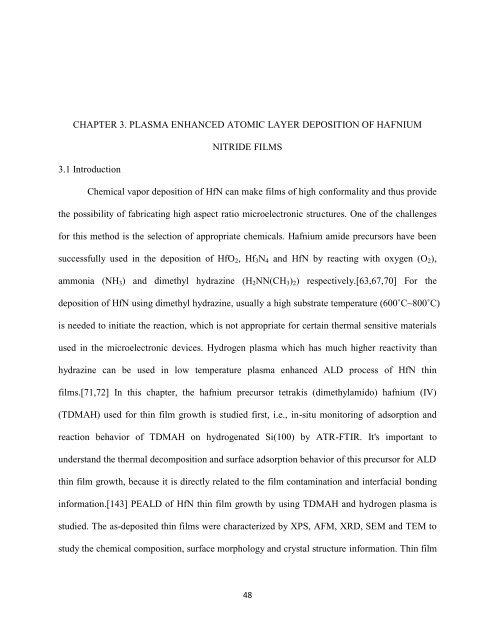CHEMICAL VAPOR DEPOSITION OF THIN FILM MATERIALS FOR ...
CHEMICAL VAPOR DEPOSITION OF THIN FILM MATERIALS FOR ...
CHEMICAL VAPOR DEPOSITION OF THIN FILM MATERIALS FOR ...
Create successful ePaper yourself
Turn your PDF publications into a flip-book with our unique Google optimized e-Paper software.
CHAPTER 3. PLASMA ENHANCED ATOMIC LAYER <strong>DEPOSITION</strong> <strong>OF</strong> HAFNIUM<br />
3.1 Introduction<br />
NITRIDE <strong>FILM</strong>S<br />
Chemical vapor deposition of HfN can make films of high conformality and thus provide<br />
the possibility of fabricating high aspect ratio microelectronic structures. One of the challenges<br />
for this method is the selection of appropriate chemicals. Hafnium amide precursors have been<br />
successfully used in the deposition of HfO2, Hf3N4 and HfN by reacting with oxygen (O2),<br />
ammonia (NH3) and dimethyl hydrazine (H2NN(CH3)2) respectively.[63,67,70] For the<br />
deposition of HfN using dimethyl hydrazine, usually a high substrate temperature (600˚C~800˚C)<br />
is needed to initiate the reaction, which is not appropriate for certain thermal sensitive materials<br />
used in the microelectronic devices. Hydrogen plasma which has much higher reactivity than<br />
hydrazine can be used in low temperature plasma enhanced ALD process of HfN thin<br />
films.[71,72] In this chapter, the hafnium precursor tetrakis (dimethylamido) hafnium (IV)<br />
(TDMAH) used for thin film growth is studied first, i.e., in-situ monitoring of adsorption and<br />
reaction behavior of TDMAH on hydrogenated Si(100) by ATR-FTIR. It's important to<br />
understand the thermal decomposition and surface adsorption behavior of this precursor for ALD<br />
thin film growth, because it is directly related to the film contamination and interfacial bonding<br />
information.[143] PEALD of HfN thin film growth by using TDMAH and hydrogen plasma is<br />
studied. The as-deposited thin films were characterized by XPS, AFM, XRD, SEM and TEM to<br />
study the chemical composition, surface morphology and crystal structure information. Thin film<br />
48

















